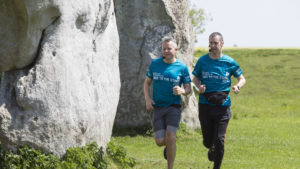
In a hurry to get your marathon game up to scratch? Saucony Uk coach Nick Anderson has provided you with some quick tips to help you ace the whole 26 mile distance.
One week away:
Don’t taper too much… yes, you can have too many rest days and then feel sluggish by race day.
Don’t chase time or worry about the GPS stats, just run easy and keep relaxed.
If you feel strong then consider a light session on the Tuesday; for example 30 minutes including 3 x 5 mins at threshold or your marathon pace with a 2 minute jog as recovery. You are just keeping your legs used to a little pace and feeling faster.
Nutrition – getting it right in the last week:
Your body needs the quality calories to keep your glycogen (carbohydrate stores) topped up so you feel great in training and on race day.
Eat your normal pre-race or pre- long run breakfast. Don’t suddenly change what has worked so well for you in training.
Don’t stuff yourself silly on the night before the race; it will only leave you feeling sluggish on race day.
The final 24 hours:
Consider a light 15-20 minute jog in the morning the day before the race to help ease tension and to warm up before stretching.
Snack on small meals throughout the day and stay well hydrated.
Eat your last main meal at 6-7pm and snack on easily digested carbohydrate snacks afterwards if needed.
Race day:
Keep your kit simple and wear the shoes you ran your last few long runs or half marathons in and make sure any clothing has been worn and washed a few times before you race in it – don’t try anything new.
Take a carbohydrate-based snack (for example a banana or energy bar) and sports drink to snack on between breakfast and the race start and be prepared with fuel in case of a delayed start.
Sip your final mouthfuls of water/sports drink but don’t take on more than normal, you don’t need it.
Your race strategy:
As the gun goes, count to 10 and slow down if you are on a faster start…. you really need to ease into your race day pace in the first few kms rather than running too quickly
Definitely don’t try to bank faster miles and get ahead of the schedule. This is a sure way to guarantee hitting the wall in the final third of the race and you are using up those carbohydrate stores too quickly.
Nutrition – getting it right in the last week
We see so many runners getting this wrong during the taper and ruining months of hard work. It’s all actually really simple – just eat normally and gradually reduce the volume and intensity of your training – this is a natural carb load.
Your body needs the quality calories to keep your glycogen (carbohydrate stores) topped up so you feel great in training and on race day.
Our simple catch phrase is ‘never hungry, never over full’ and grazing throughout the day with snacks and sensible main meals will work well.
Eat your normal pre-race or pre- long run breakfast. Don’t suddenly change what has worked so well for you in training.
You want your body to feel normal and comfortable on the start line so now is not the time to suddenly try porridge or some wonder meal if you are not used to it.
Don’t stuff yourself silly on the night before the race; it will only leave you feeling sluggish on race day.
The Final 24 Hours
Consider a light 15-20 minute jog in the morning the day before the race to help ease tension and to warm up before stretching.
Take a look at the weather forecast for race day and wear whatever is going to keep you cool and comfortable.
Pack your kit bag with all that you will need on race day – pins, warm clothes, toilet paper, Vaseline, snacks, fluids, iPod and ensure your number is pinned on your vest and chip on your shoes.
Avoid spending ages on your feet walking with family and friends sight seeing or at the expo.
Snack on small meals throughout the day and stay well hydrated.
Eat your last main meal at 6-7pm and snack on easily digested carbohydrate snacks afterwards if needed.
Get to bed early! If you find it hard to sleep don’t worry – this is normal but stay in bad and rest, read and relax.
On Race Day:
Wow it’s finally here and now it really is time to keep your head. Time to remember those 3 runs that went well in training that you have banked or the cause and reason for which you are racing.
Wake early, shower, and take a few moments to breathe deeply, relax and stay calm.
Eat the race day breakfast you have practiced in training before you long runs 1.5-2 hours before race start
Keep your kit simple and wear the shoes you ran your last few long runs or half marathons in and make sure any clothing has been worn and washed a few times before you race in it, don’t try anything new.
Take a carbohydrate-based snack (for example a banana or energy bar) and sports drink to snack on between breakfast and race start and be prepared with fuel in case of a delayed start.
Look around you and focus in on the target you have set. Remember your pace, split times and don’t rely on your GPS…they often fail with so many signals in the same area. Have your splits per mile written on your hand, arm in permanent ink or on a wristband.
Sip your final mouthfuls of water/sports drink but don’t take on more than normal, you don’t need it.
Don’t run to warm up or do any high intensity drills – save your energy and use the first few miles to warm up.
Hand your kit in and perhaps have an old tracksuit and bin liner or previous race foil blanket on to stay warm, and head to your pen 20-30 minutes before the start. In the final minutes take your old kit off.
Your Race Strategy:
As the gun goes, count to 10 and slow down if you are on a faster start…. you really need to ease into your race day pace in the first few km’s rather than running too quickly.
Those of you on the mass slower starts should use the walk to the start line after the gun has gone and the early crowded miles as your perfect warm up. You have 26 miles ahead of you and lots of time to gradually catch up on that pace.
Run at the pace you have practiced. After building into the pace you should then look to lock into the km or mile splits that became familiar to you in the marathon pace sessions and longer runs.
Definitely don’t try to bank faster miles and get ahead of the schedule. This is a sure way to guarantee hitting the wall in the final third of the race and you are using up those carbohydrate stores too quickly.
Perhaps try running a touch under your marathon pace in the first 10k, then at your planned mp for the middle 20k and then through the kitchen sink at it over the last 12k.
We recommend you take on gels every 30 mins on race day and you should have practiced this on some long training runs. Take your first gel at 30-45 minutes and then every 30 minutes for the rest of the race.
Sip on sports drink and/or water occasionally in the race. You don’t need too much and be sure to not over drink on the way round.
Watch the pinch points stay calm’. There will be areas on course where the crowds will make you feel like an Olympic marathon champion. Before you know it your pace has picked up and you are running too fast! Feel great and let the hairs on the back of your neck do their thing but slow down and stay calm, as the real marathon doesn’t start until you reach 20 miles!
Yep that’s right, 20 miles, that’s when the real fun and challenge begins. If you have trained well, tapered smartly, run at a race pace you have practiced and taken your gels and drinks early on you can attacked the final 6 miles making it home tired but with style. Get any of these key elements wrong and it’s the hardest 6 miles of your life.
That’s why the marathon must be respected. Remember to smile, take time to relax and draw in the atmosphere, marathon memories last a lifetime.
For more on Nick Anderson and Saucony, go to Saucony.com.
Comedians Paul Tonkinson and Rob Deering give ultra-marathon runners their top tips on how to break the wall Paul’s top tips… Get some long runs in The […]
When clients come to me wanting to enhance their training potential, one of the biggest pitfalls is that I see them start to eat way more carbs […]



